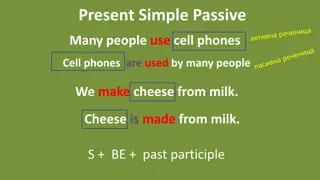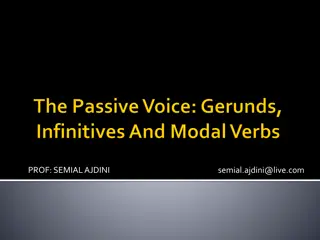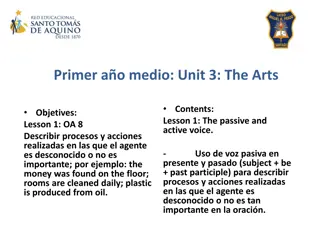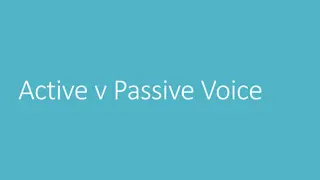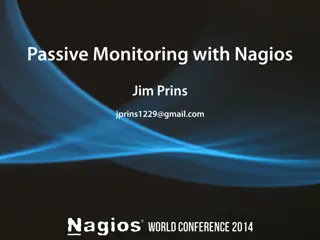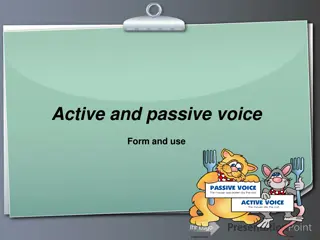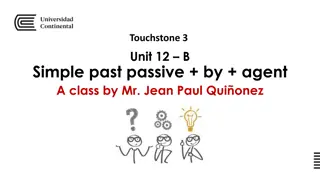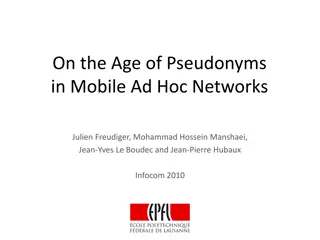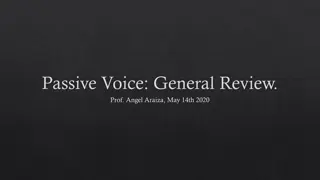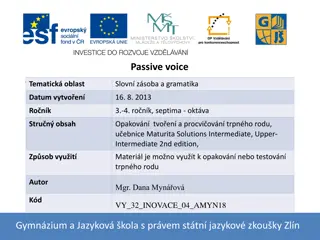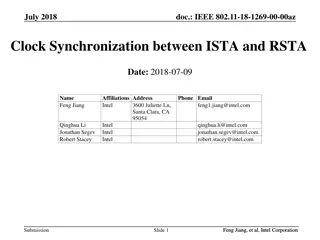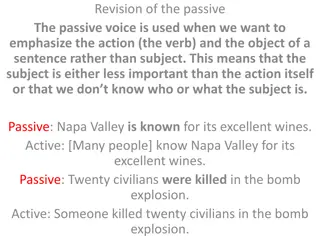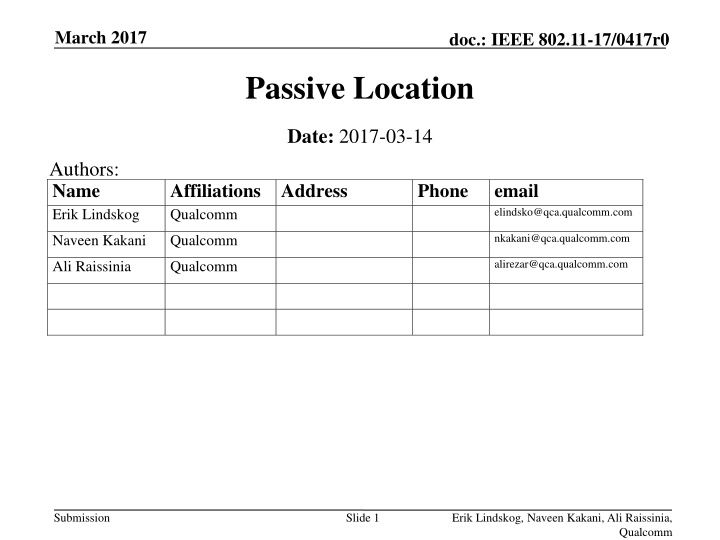
Passive Location Methodology for IEEE 802.11az
Explore the passive ranging case for 802.11az, focusing on scheduling methodology, multi-user, and multi-antenna ranging. Learn about using anchor stations and hyperbolic navigation for passive location in WiFi-enabled environments.
Download Presentation

Please find below an Image/Link to download the presentation.
The content on the website is provided AS IS for your information and personal use only. It may not be sold, licensed, or shared on other websites without obtaining consent from the author. If you encounter any issues during the download, it is possible that the publisher has removed the file from their server.
You are allowed to download the files provided on this website for personal or commercial use, subject to the condition that they are used lawfully. All files are the property of their respective owners.
The content on the website is provided AS IS for your information and personal use only. It may not be sold, licensed, or shared on other websites without obtaining consent from the author.
E N D
Presentation Transcript
March 2017 doc.: IEEE 802.11-17/0417r0 Passive Location Date: 2017-03-14 Authors: Name Erik Lindskog Affiliations Address Qualcomm Phone email elindsko@qca.qualcomm.com nkakani@qca.qualcomm.com Naveen Kakani Qualcomm alirezar@qca.qualcomm.com Ali Raissinia Qualcomm Submission Slide 1 Erik Lindskog, Naveen Kakani, Ali Raissinia, Qualcomm
March 2017 doc.: IEEE 802.11-17/0417r0 Abstract This presentation discusses passive location for 802.11az, including scheduling methodology as well as multi-user and multi-antenna ranging as it pertains to the passive ranging case. Submission Slide 2 Erik Lindskog, Naveen Kakani, Ali Raissinia, Qualcomm
March 2017 doc.: IEEE 802.11-17/0417r0 TDOA - Hyperbolic Navigation Source: http://asadahmedansari6395.blogspot.ca/2016_04_01_archive.html Submission Slide 3 Erik Lindskog, Naveen Kakani, Ali Raissinia, Qualcomm
March 2017 doc.: IEEE 802.11-17/0417r0 Introduction By arranging (E)FTM exchanges between stationary stations, call them anchor stations (AS), one can enable a client station to derive its differential distance to the two stations. With multiple such (E)FTM exchanges between multiple pairs of anchor stations, the location of the client station can be derived in a hyperbolic navigation scheme. These anchor stations can, say, be stationary devices such as: WiFi access points Wireless speakers Security cameras Printers Electronic locks/access control devices Alarm system components Appliances and appliance controls Etc. Your average venue will contain a large multitude of such devices, many of them WiFi enabled and powered, that can be used to enable passive WiFi location. Submission Slide 4 Erik Lindskog, Naveen Kakani, Ali Raissinia, Qualcomm
March 2017 doc.: IEEE 802.11-17/0417r0 Passive Location Anchor Station AS1 AS2 Access Point 0 AS TDOA AP0 Client AP AS3 AS Submission Slide 5 Erik Lindskog, Naveen Kakani, Ali Raissinia, Qualcomm
doc.: IEEE 802.11-17/0417r0 SU Legacy FTM Based Passive Ranging - Recap Submission Slide 6 Erik Lindskog, Naveen Kakani and Ali Raissinia, Qualcomm
March 2017 doc.: IEEE 802.11-17/0417r0 Timing Relations Note that all these transmissions, as depicted here, take place in the channel of AP0. Ranging periodicity Ranging periodicity FTM procedure FTM procedure FTM procedure AP0 transmissions FTM t1, t4 ACK FTM SIFS Neighboring AS transmissions FTM Request ACK ACK Transmitted at times t1 Received at time t2 by AS1 Received at time t5 by the client Transmitted at time t3 Received at time t4 by AP0 Received at time t6 by the client Submission Slide 7 Erik Lindskog, Naveen Kakani, Ali Raissinia, Qualcomm
March 2017 doc.: IEEE 802.11-17/0417r0 Propagation paths and time stamps Illustrating timing diagram: AP0 AS1 Client t1 FTM t2 t3 ACK t5 t4 t6 Submission Slide 8 Erik Lindskog, Naveen Kakani, Ali Raissinia, Qualcomm
March 2017 doc.: IEEE 802.11-17/0417r0 Calculation of differential distance The differential distance between a client station and two ASs exchanging EFTM messages can be calculated as follows. The client station listens to the EFTM exchange between the two ASs and records the time t5 when it receives the FTM from AP0 and the time t6 when it receives the (FTM) ACK from AS1. Furthermore the client listens to the reporting of t1 and t4 from AP0. The differential distance from the client to AP0 and AS1 can then be calculated as: D_delta_client_01 = [t5 t6 (t4 t1-T_01) ]* c where T_01 is the time of flight for a signal between AP0 and AS1 and c is the speed of light Submission Slide 9 Erik Lindskog, Naveen Kakani, Ali Raissinia, Qualcomm
doc.: IEEE 802.11-17/0417r0 MU-MIMO EFTM Based Passive Ranging Submission Slide 10 Erik Lindskog, Naveen Kakani and Ali Raissinia, Qualcomm
doc.: IEEE 802.11-17/0417r0 MU-MIMO EFTM Based Passive Ranging Use MU-MIMO EFTM measurement sequence proposed in [1]: Submission Slide 11 Erik Lindskog, Naveen Kakani and Ali Raissinia, Qualcomm
doc.: IEEE 802.11-17/0417r0 MU-MIMO EFTM Based Passive Ranging Beacon Interval Beacon Interval MU-MIMO EFTM Procedure MU-MIMO EFTM Procedure MU-MIMO EFTM Procedure Beacon Beacon Beacon Trigger Frame DL Trigger Frame AP2STA: t_2k:s and t_3 AP0 transmissions NDPA+NDP SIFS SIFS SIFS SIFS STA2AP UL MU ACK t1_k:s and t4_k:s Neighboring ASs transmissions UL MU NPD SIFS DL NDP transmitted at time t3 Received at time t4_k by ASk Received at time t6 by the client Transmitted at times t1_k Received at time t2_k by AP0 Received at time t5_k by the client Possibly preceded by a polling step Submission Slide 12 Erik Lindskog, Naveen Kakani and Ali Raissinia, Qualcomm
March 2017 doc.: IEEE 802.11-17/0417r0 Staggered UL MU NDP As in [2]: Trigger AP0 Frame SIFS SIFS NDP Neighbor AS1 SIFS Neighbor AS2 NDP SIFS NDP Neighbor AS3 Staggered NDP TOD t1_2 TOA t2_2 TOD t1_1 TOA t2_1 TOD t1_3 TOA t2_3 Submission Slide 13 Erik Lindskog, Naveen Kakani, Ali Raissinia, Qualcomm
March 2017 doc.: IEEE 802.11-17/0417r0 Symbol Interleaved UL MU NDP option As in [2]: Trigger Frame AP0 SIFS SIFS SIFS Neighbor AP1 MU-NDP Neighbor AP2 MU-NDP Neighbor AP3 MU-NDP Compressed NDP HE NDP header (all STA transmits) HE-STF STA1 HE-LTF STA1 HE-LTF STA1 HE-STF STA2 HE-LTF STA2 HE-STF STA3 HE-LTF STA3 Full BW MU-NDP TOD t1_1 TOA t2_1 TOD t1_2 TOA t2_2 TOD t1_3 TOA t2_3 Note: The idea is that the header in the packet reserves the media for the duration of the packet, especially as it is transmitted by all responding STAs and thus is likely to be heard quite well. Submission Slide 14 Erik Lindskog, Naveen Kakani, Ali Raissinia, Qualcomm
March 2017 doc.: IEEE 802.11-17/0417r0 Propagation paths and time stamps Illustrating timing diagram: Client AS1 AP0 t1_1 UL MU NDP t2_1 t5_1 DL NDP t3 t4_1 t2_1, t3 AP to STA feedback t6 t1_1, t4_1 STA to AP feedback Submission Slide 15 Erik Lindskog, Naveen Kakani, Ali Raissinia, Qualcomm
March 2017 doc.: IEEE 802.11-17/0417r0 Differential Distance Calculation The client STA listens to the exchanges between the AP0 and AS1 and records the time t5_1 when it receives the UL MU NDP from AS1 and the time t6 when it receives the DL NDP from AP0. The client also listens to the relayed t2_k:s and t3 from AP0 and the relayed t1_k:s and t4_k:s in the feedback from the neighboring ASs. The differential distance between the client STA and AP0 vs. AS1 can now be calculated as follows: D_01 = [t6 t5_1 (t3 t2_1 + T_01)] * c Using T_01 = [(t4_1 t1_1) (t3 t2_1)]/2 We get D_01 = [t6 t5_1 (t3 t2_1 + 0.5*t4_1 0.5*t1_1 0.5*t3 + 0.5*t2_1)]*c Or finally: D_01 = [t6 t5_1 0.5*t3 + 0.5*t2 0.5*t4_1 + 0.5*t1_1]*c Note that the above expression for the differential distance D_01 does not depend on the ToF between AP0 and AS1. Thus this method of calculating D_01 is insensitive to LOS obstructions between AP0 and AS1. Submission Slide 16 Erik Lindskog, Naveen Kakani, Ali Raissinia, Qualcomm
March 2017 doc.: IEEE 802.11-17/0417r0 Rough Estimates of Overhead Assume: we do the passive ranging once per second a channel switching time of 100 us each AP does ranging with 5 other APs a generic packet/frame length of 100 us about 25 us extra per user in the symbol interleaved UL MU NDP Using the staggered UL MU NDP option: Overhead is about 5*(2*100e-6+ (7+5)*100e-6)/1 = 0.70 % Using the symbol interleaved UL MU NDP option: Overhead is about 5*(2*100e-6+7*100e-6+5*25e-6)/1 = 0.51 % Submission Slide 17 Erik Lindskog, Naveen Kakani, Ali Raissinia, Qualcomm
March 2017 doc.: IEEE 802.11-17/0417r0 Schedule Setup and Signaling for Passive Ranging Submission Slide 18 Erik Lindskog, Naveen Kakani, Ali Raissinia, Qualcomm
March 2017 doc.: IEEE 802.11-17/0417r0 Scheduling of (E)FTM Transmissions The (E)FTM exchanges may be scheduled in the vicinity of a selection of beacons which may minimize the disruptions to operations. May minimize disruptions in an communications May minimize clients expended power as they can listen to beacon at same time In general, when the ASs are APs, the APs need periodically switch to the channels of their neighboring AP(s) to do (E)FTM exchanges. The client does not necessarily need to hop around to the channels of other APs BSSs. The client may choose to only snoop the (E)FTM exchanges on a single APs channel. (E.g. its own AP, here AP0.) Submission Slide 19 Erik Lindskog, Naveen Kakani, Ali Raissinia, Qualcomm
March 2017 doc.: IEEE 802.11-17/0417r0 Schedule negotiation The schedule and operation of the (E)FTM transmissions between the AP/ASs need to be negotiated and signaled. In 802.11Revmc the ranging schedule is negotiated by the Initiator STA suggesting a ranging periodicity and start time phase. The responding STA may then override this schedule. To enable an AP to setup (E)FTM exchanges on its own channel with it is helpful to have an (E)FTM negotiation process where the initiator has the final say: Initiator STA is the one that could be possibly advertising the Passive Ranging Service Allows STAs that are able to listen to the service can remain on the same channel for Passive Ranging Service To facilitate a version of the negotiation where the initiating STA has the final say in the negotiation, consider enabling an (E)FTM negotiation that uses the same (E)FTM negotiation with the following change: Add bit to indicate in the FTM Request to signal that the initiator has the final say for some of the parameters - this is limited to Passive Ranging Functionality only the (E)FTM may take place on a different channel (Ex: Initiator is on the Channel of the Responder for negotiation) and bandwidth than the actual negotiation. Submission Slide 20 Erik Lindskog, Naveen Kakani, Ali Raissinia, Qualcomm
March 2017 doc.: IEEE 802.11-17/0417r0 Schedule Content (1) One can define two levels of Signaling the schedule for the (E)FTM exchanges The first level is for the case where the schedule an AP conveys is only for (E)FTM exchanges taking place in the channel of its BSS: Schedule of (E)FTM Exchanges that includes the AP that is conveying the schedule The Schedule is signaled with times on the clock domain of the AP signaling the Schedule The second level is for the case where the AP conveys schedule of (E)FTM exchanges taking place in channels of neighboring APs and that include the AP sending the schedule The schedule signaled by the AP can be with respect to the times defined in the neighboring APs clock domains. Submission Slide 21 Erik Lindskog, Naveen Kakani, Ali Raissinia, Qualcomm
March 2017 doc.: IEEE 802.11-17/0417r0 Schedule Content (2) Components that need to be conveyed in first level of complexity of schedule: When are the (E)FTM exchanges scheduled Time phase and periodicity (in the schedule announcing APs clock domain ASs involved and their role (initiators or responders) STA ID/BSSID, STA is AP/Client, Responder/Initiator role Parameters for the (E)FTM exchanges, like Type of (E)FTM, Number of antennas used, Support for AOD estimation, etc. LCI information of the APs involved Additional components needed for the second level of complexity of the schedule: Channels and bandwidths of the (E)FTM exchanges The AS clock domains the (E)FTMs are scheduled in Mappings of the neighboring ASs clocks onto the schedule announcing APs clock domain. Submission Slide 22 Erik Lindskog, Naveen Kakani, Ali Raissinia, Qualcomm
March 2017 doc.: IEEE 802.11-17/0417r0 Conveying the Schedule The signaling of the schedule can be periodically broadcast in an APs beacons. In every beacon the AP can advertise a counter. This counter indicates how many more beacons until the APs beacon contains the (E)FTM exchange schedule for the passive ranging support. The AP includes the schedule in the beacon when the counter reaches 0. In addition, the schedule can be included in a Probe Response (to a Probe Request from a client STA). Submission Slide 23 Erik Lindskog, Naveen Kakani, Ali Raissinia, Qualcomm
March 2017 doc.: IEEE 802.11-17/0417r0 Promises and Challenges Submission Slide 24 Erik Lindskog, Naveen Kakani, Ali Raissinia, Qualcomm
March 2017 doc.: IEEE 802.11-17/0417r0 Scalability Relies on broadcast to clients to be located Clients do not need to transmit => Unlimited Scalability Submission Slide 25 Erik Lindskog, Naveen Kakani, Ali Raissinia, Qualcomm
March 2017 doc.: IEEE 802.11-17/0417r0 Synchronization Clock offsets errors gets cancels in calculations Uses temporally localized time-stamped frame exchanges => Limited susceptibility to clock stability No Synchronization nor Extremely Stable Clocks Needed Submission Slide 26 Erik Lindskog, Naveen Kakani, Ali Raissinia, Qualcomm
March 2017 doc.: IEEE 802.11-17/0417r0 Client Calibration No Tx group delay calibration needed Client is not transmitting (E)FTM frames Possibly no Rx group delay calibration needed Each set of (E)FTM frames are received on the same channel and bandwidth Group delay differences due to Rx gain change may be present but can be designed to be small => Possibly No Calibration Needed Submission Slide 27 Erik Lindskog, Naveen Kakani, Ali Raissinia, Qualcomm
March 2017 doc.: IEEE 802.11-17/0417r0 Security No encryption needed Client stations only listen Possibly no authentication needed Service is broadcast => In general attacker does not know who he is attacking Hard to spoof signals to provide a false location => Possibly No Security Needed Submission Slide 28 Erik Lindskog, Naveen Kakani, Ali Raissinia, Qualcomm
March 2017 doc.: IEEE 802.11-17/0417r0 Summary of Promises and Challenges Promises Passive location for unlimited number of clients No synchronization of anchor stations clocks needed Possibly no calibration needed No encryption needed Possibly no authentication needed Challenges Scheduling of (E)FTM exchanges AP/ASs time-outs due to do (E)FTM exchanges with other AP/ASs Some constraint due to supported reception of broadcast frames Submission Slide 29 Erik Lindskog, Naveen Kakani, Ali Raissinia, Qualcomm
doc.: IEEE 802.11-17/0417r0 References [1] NDP-Based Measurement Protocol , IEEE 11-17-0050-02-00az-ndp- based-measurement-protocol. [2] HE-FTM Measurement Phase , IEEE 11-17-0144-00-00az-he-ftm- mesurement-phase.pptx. Submission Slide 30 Erik Lindskog, Naveen Kakani and Ali Raissinia, Qualcomm





